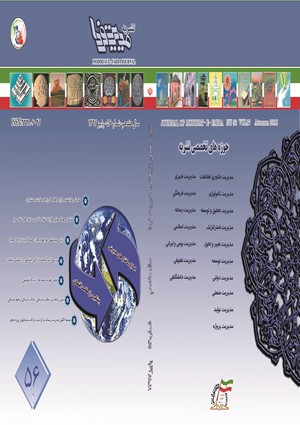بررسی رفتار مشتریان بانک پس از ادغام شعب با توسعهی یک مدل تحلیل خوشهای؛ مطالعه موردی: بانک ملت
الموضوعات :
1 - مهندسی صنایع و سیستمهای مدیریت
الکلمات المفتاحية: ادغام شعب , ریزش مشتریان, تحلیل خوشهای.,
ملخص المقالة :
ظهور و گسترش کانالهای خدمتدهی جدید در بانکها ، تعداد زیاد شعب در شبکهی خدمترسانی بانکها و هزینههای بالای شعبه از یک سو بانکها را به سمت کاهش تعداد شعب خود و ادغام شعبههای کوچکتر در سایر شعب سوق داده است؛ اما عواملی از قبیل از دست دادن مشتریان، پوشش برند، محرومیتهای مالی اجتماعی و... ملاحظاتی را برای بانکها در ادغام شعب ایجاد کرده است. در این مقاله ابتدا به مرور جامعی از ادبیات ادغام شعب بانکها و مسائل مشابه آن پرداخته شده و متغیرهای تأثیرگذار در مسئله شناسایی شده است. سپس به بررسی رفتار مشتریان متأثر از ادغام شعب به عنوان یکی از کلیدیترین متغیرهای مؤثر در مسئله پرداخته شده است. بدین منظور یک مدل پنج مرحلهای در این مقاله توسعه یافته است که هستهی اصلی آن را استفاده از تکنیکهای تحلیل خوشهای تشکیل داده است. در انتها به منظور نمایش اثربخشی و کاربردی بودن مدل توسعه یافته، از مطالعهی موردی شعب بانک ملت در سطح کشور استفاده شده است.
[1] Berger, Allen N., David B. Humphrey. 1994. “Bank Scale Economies, Mergers, Concentration, and Efficiency: The U.S. Experience.” University of Pennsylvania (Working Paper).
[2] Brechmann, Eike Christian, Claudia Czado, Peggy Ng. 2000. “Quantifying geographical and macroeconomic effects on bank branch deposits using linear mixed models.”
[3] Morrison, Philip S., Rachel O’Brien. 2001. “Bank branch closures in New Zealand: the application of a spatial interaction model.” Applied Geography 21 (4): 301-303.
[4] Huff, David L. 1964. “Defining and Estimating a Trading Area.” Journal of Marketing 28 (3): 34-38.
[5] Li, Chu-Fen. 2007. “Problems in Bank Branch Inefficiency: Management, Scale and Location.” Asian Journal of Management and Humanity Sciences 1: 523-538.
[6] Okeahalam, Charles. 2009. “Bank Branch Location: a Count Analysis.” Spatial Economic Analysis 4 (3): 275-300.
[7] Okeahalam, Charles. 2007. “Estimating market power in the South African banking sector.” International Review of Applied Economics 21: 669-685.
[8] Okeahalam, Charles. 2006. “Production efficiency in the South African banking sector: a stochastic analysis.” International Review of Applied Economics 20: 103-123.
[9] Ferreira, Fernando A. F., Ronald W. Spahr, Sérgio P. Santos, Paulo M. M. Rodrigues. 2010. “A multiple criteria framework to evaluate bank branch potential attractiveness.” CASEE 36.
[10] Capgemini Consulting. 2010. “The Future of Bank Branches Coordinating Physical with Digital.” The State of North American Digital Banking.
[11] French, Shaun, Andrew Leyshon, Sam Meek. 2013. “The Changing Geography of British Bank and Building.” University of Nottingham.
[12] Tabak, Benjamin M., Rogério Boueri Miranda, Dimas M. Fazio. 2013. “A geographically weighted approach to measuring efficiency in panel data: The case of US saving banks.” Journal of Banking & Finance 37: 3747-3756.
[13] Aigner, D., C. A. Lovell, P., Schmidt. 1977. “Formulation and estimation of stochastic frontier production function models.” Journal of Econometrics 6 (1): 21-37.
[14] Nguyen, Hoai-Luu Q. 2014. “Do Bank Branches Still Matter? The Effect of Closings on Local Economic Outcomes.”
[15] Başar, Ayfer, Özgür Kabak, Y. İlker Topçu. 2014. “Identifying the criteria and their priorities for locating bank branches in Turkey.” International Journal of the Analytic Hierarchy Process 1-5.
[16] Park, Yang Shin. 2014. Bank Merger Incentives and Market Competition: Two-sided Matching Model with Externalities. Boston University.
[17] Ruiz-Hernández, Diego, David Delgado Gómez, Joaquín López-Pascual. 2014. “Restructuring bank networks after mergers and acquisitions: A capacitated delocation model for closing and resizing branches.” Computers & Operations Research.
[18] American Bankers Association. 2012. “Rebooting the branch: Reinventing branch banking in a multichannel, global environment.”
[19] Martins, Tokunbo. 2014. “Guidelines on the establishment and rationalization of branches and other outlets for banks in Nigeria.” ABUJA: CENTRAL BANK OF NIGERIA.
[20] Accenture. 2008. “A Strategic Approach to Cost Reduction in Banking.”


